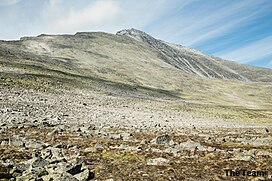Mount Narodnaya
| Mount Narodnaya | |
|---|---|
 Mount Narodnaya: View from the south. | |
| Highest point | |
| Elevation | 1,894 m (6,214 ft)[1] |
| Prominence | 1,772 m (5,814 ft)[1] |
| Listing | Ultra, Ribu |
| Coordinates | 65°02′N 60°07′E / 65.033°N 60.117°E[1] |
| Geography | |
| Location | Komi Republic/Khanty–Mansi Autonomous Okrug in Tyumen Oblast, Russia |
| Parent range | Ural Mountains |
| Climbing | |
| Easiest route | The North face |
Mount Narodnaya (also known as Naroda and Poenurr; Russian: гора Народная, Komi: Народа-Из ("People's Mountain"[2]), Mansi: Поэӈ-ур, Поэн-урр) is the highest peak of the Urals in Russia. Its elevation is 1,894 metres (6,214 ft). It is located on the border between Khanty–Mansi Autonomous Okrug in Tyumen Oblast and Komi Republic, the highest point being 0.5 km to the east from the border.[citation needed] The name may refer to Naroda River, which originates from the mount, located in the Research Range.
It is the highest point in European Russia outside the Caucasus. This leads to its large topographic prominence of 1,772 metres (5,814 ft). Narodnaya is located in the Ural mountains water divide, and therefore on the border between Europe and Asia: the Naroda river flows south-east from the summit into the Ob river in Siberia, and the Kos'yu river flows north-west from the summit into the Pechora river in Europe.
The mountain is formed with quartzites and metamorphosed slates of the Proterozoic Eon and Cambrian Period. There are some glaciers on the mountain. Also, there are sparse forests of larch and birch in the deep valleys at the foot of the mountain. The slopes of the mountain are covered with highland tundra.
The easiest route to the summit is a technically easy hike on the moderate north-west slope. Depending on snow and ice conditions, crampons may be required.[3] The south wall of Narodnaya is steeper and less commonly used to reach the summit.
See also
[edit]References
[edit]- ^ a b c "European Russia and the Caucasian States: Ultra-Prominence Page". Peaklist.org. Retrieved 2013-06-24.
- ^ "Физико-географическая статистика России". Archived from the original on 2014-05-25. Retrieved 2008-07-08.
- ^ "The Circumpolar Urals". Risk Online.
External links
[edit]


 French
French Deutsch
Deutsch
